201 MITSUBISHI ECLIPSE CROSS 2020 Owner's Manual (in English)
[x] Cancel search | Manufacturer: MITSUBISHI, Model Year: 2020, Model line: ECLIPSE CROSS, Model: MITSUBISHI ECLIPSE CROSS 2020Pages: 427, PDF Size: 78.05 MB
Page 2 of 427
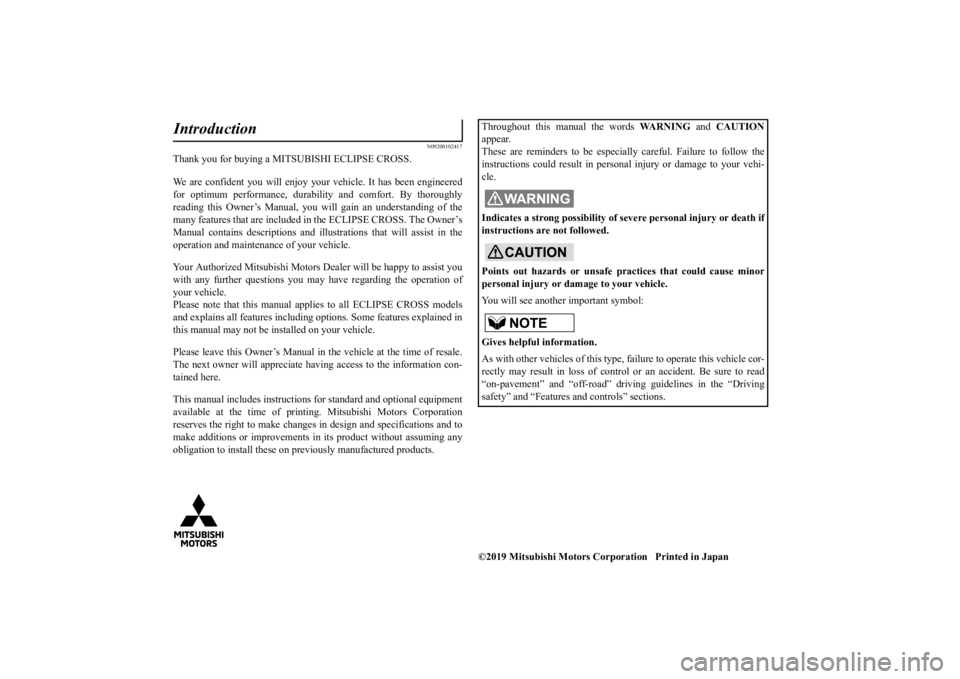
N09200102417
Thank you for buying a MITSUBISHI ECLIPSE CROSS. We are confident you will enjoy your vehicle. It has been engineered for optimum performance, durabi
lity and comfort. By thoroughly
reading this Owner’s Manual, you
will gain an understanding of the
many features that are included in the ECLIPSE CROSS. The Owner’sManual contains descriptions and illus
trations that will assist in the
operation and maintenance of your vehicle. Your Authorized Mitsubishi Motors
Dealer will be happy to assist you
with any further questions you may have regarding the operation ofyour vehicle. Please note that this manual app
lies to all ECLIPSE CROSS models
and explains all features including
options. Some features explained in
this manual may not be installed on your vehicle. Please leave this Owner’s Manual in th
e vehicle at the time of resale.
The next owner will appreciate having access to the information con- tained here. This manual includes instructions fo
r standard and optional equipment
available at the time of printing
. Mitsubishi Motors Corporation
reserves the right to make changes in design and specifications and to make additions or improvements in
its product without assuming any
obligation to install these on previously manufactured products.Introduction
Throughout this manual the words
WARNING
and
CAUTION
appear. These are reminders to be especia
lly careful. Failure to follow the
instructions could result in persona
l injury or damage to your vehi-
cle. Indicates a strong possibility of se
vere personal injury or death if
instructions are not followed. Points out hazards or unsafe pr
actices that could cause minor
personal injury or damage to your vehicle. You will see another important symbol: Gives helpful information. As with other vehicles of this type, failure to operate this vehicle cor- rectly may result in loss of control or an accident. Be sure to read “on-pavement” and “off-road” driving guidelines in the “Drivingsafety” and “Features and controls” sections.©2019 Mitsubishi Motors Corp
oration Printed in Japan
BK0277700US.bo
ok 1 ページ 2019年3月8日 金曜日 午前9時23分
Page 5 of 427
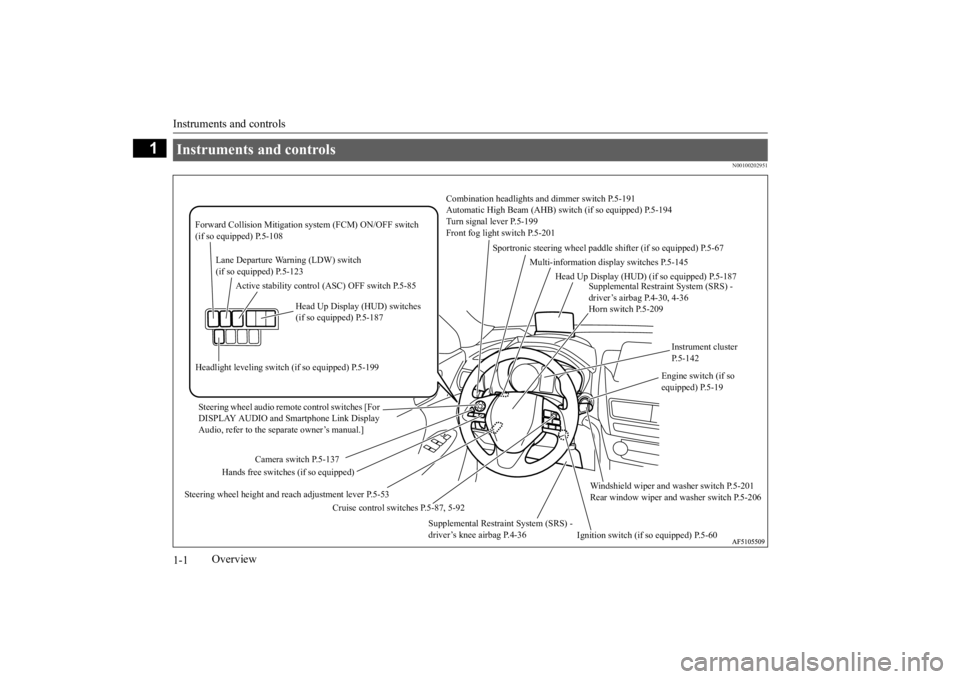
Instruments and controls 1-1
1
Overview
N00100202951
Instruments and controls
Combination headlights an
d dimmer switch P.5-191
Automatic High Beam (AHB) sw
itch (if so equipped) P.5-194
Turn signal lever P.5-199 Front fog light switch P.5-201
Steering wheel audio remote control switches [For DISPLAY AUDIO and Smartphone Link Display Audio, refer to the separate owner’s manual.]
Active stability control (ASC) OFF switch P.5-85
Supplemental Restraint System (SRS) - driver’s airbag P.4-30, 4-36Horn switch P.5-209
Instrument cluster P.5-142
Windshield wiper and washer switch P.5-201 Rear window wiper and
washer switch P.5-206
Cruise control switches P.5-87, 5-92
Steering wheel height and reach adjustment lever P.5-53
Engine switch (if so equipped) P.5-19
Sportronic steering wheel paddle
shifter (if so equipped) P.5-67
Lane Departure Warning (LDW) switch (if so equipped) P.5-123
Forward Collision Mitigation
system (FCM) ON/OFF switch
(if so equipped) P.5-108
Supplemental Restraint System (SRS) - driver’s knee airbag P.4-36
Ignition switch (if so equipped) P.5-60
Head Up Display (HUD) switches (if so equipped) P.5-187
Headlight leveling switch
(if so equipped) P.5-199
Camera switch P.5-137
Hands free switches (if so equipped)
Multi-information display switches P.5-145
Head Up Display (HUD)
(if so equipped) P.5-187
BK0277700US.bo
ok 1 ページ 2019年3月8日 金曜日 午前9時23分
Page 6 of 427
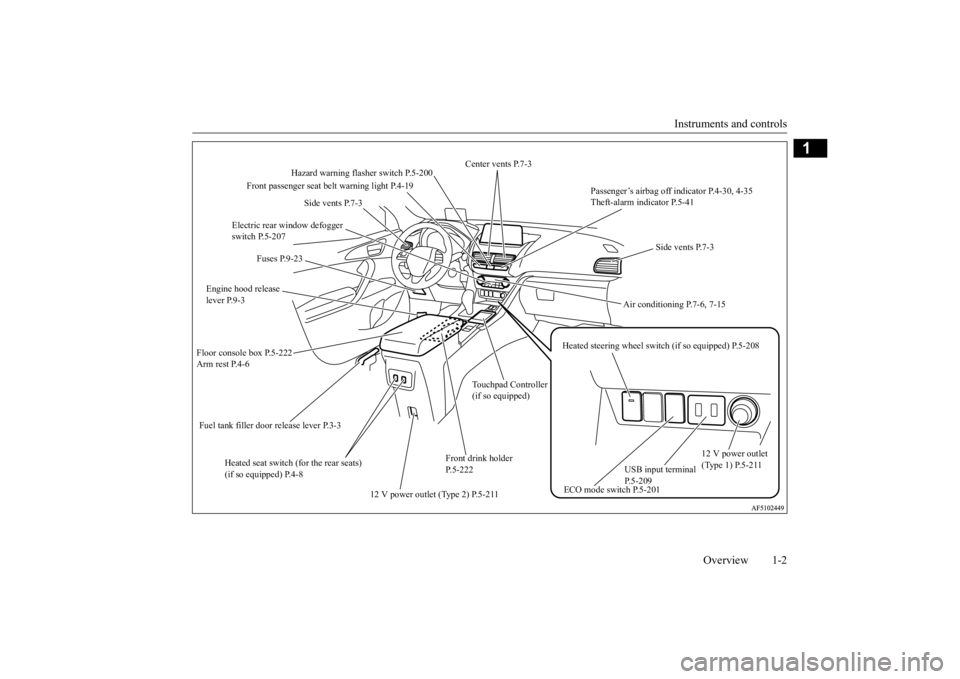
Instruments and controls
Overview 1-2
1
Hazard warning flasher switch P.5-200
Electric rear window defogger switch P.5-207
Fuel tank filler door release lever P.3-3 Engine hood release lever P.9-3 Floor console box P.5-222 Arm rest P.4-6
12 V power outlet (Type 1) P.5-211
Air conditioning P.7-6, 7-15
Passenger’s airbag off indicator P.4-30, 4-35 Theft-alarm indicator P.5-41
Front passenger seat belt warning light P.4-19
Heated steering wheel switc
h (if so equipped) P.5-208
Heated seat switch (for the rear seats) (if so equipped) P.4-8
Side vents P.7-3
ECO mode switch P.5-201
USB input terminal P.5-209
Center vents P.7-3
Fuses P.9-23
Front drink holder P.5-222
Side vents P.7-3
12 V power outlet (Type 2) P.5-211
Touchpad Controller (if so equipped)
BK0277700US.bo
ok 2 ページ 2019年3月8日 金曜日 午前9時23分
Page 11 of 427
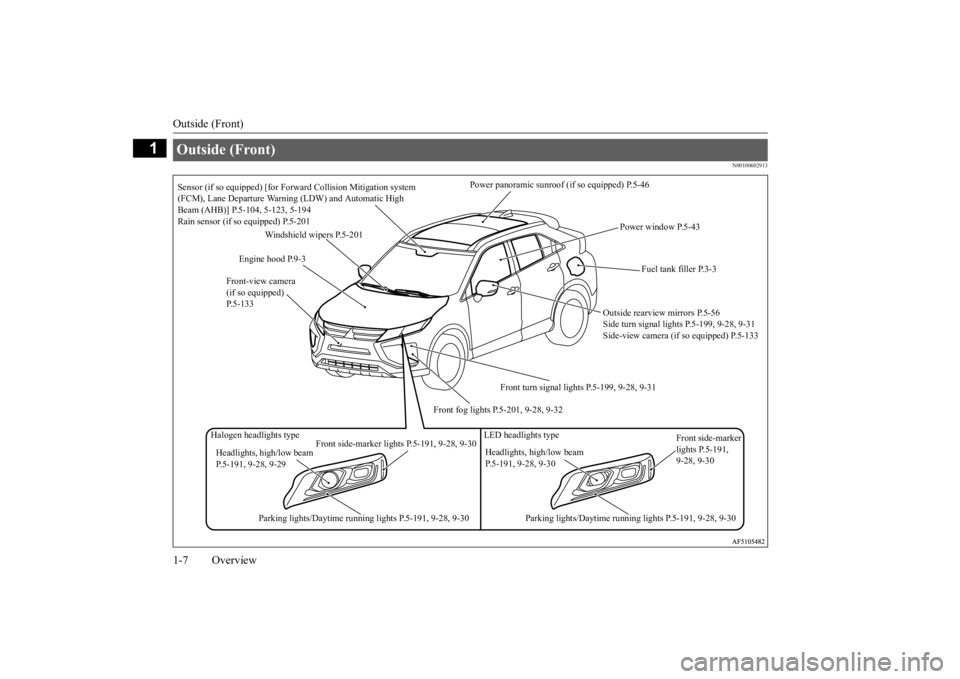
Outside (Front) 1-7 Overview
1
N00100602913
Outside (Front)
Power panoramic sunroof
(if so equipped) P.5-46
Windshield wipers P.5-201
Engine hood P.9-3
Front fog lights P.5-201, 9-28, 9-32
Outside rearview mirrors P.5-56 Side turn signal lights P.5-199, 9-28, 9-31Side-view camera (if so equipped) P.5-133
Fuel tank filler P.3-3
Power window P.5-43
Front turn signal lights P.5-199, 9-28, 9-31
Headlights, high/low beam P.5-191, 9-28, 9-29
Headlights, high/low beam P.5-191, 9-28, 9-30
Parking lights/Daytime running lights P.5-191, 9-28, 9-30
Parking lights/Daytime running lights P.5-191, 9-28, 9-30
Halogen headlights type LED headlights type
Front side-marker lights P.5-191, 9-28, 9-30
Front side-marker lights P.5-191, 9-28, 9-30
Sensor (if so equipped) [for Fo
rward Collision Mitigation system
(FCM), Lane Departure Warn
ing (LDW) and Automatic High
Beam (AHB)] P.5-104, 5-123, 5-194 Rain sensor (if so equipped) P.5-201
Front-view camera (if so equipped) P.5-133
BK0277700US.bo
ok 7 ページ 2019年3月8日 金曜日 午前9時23分
Page 24 of 427
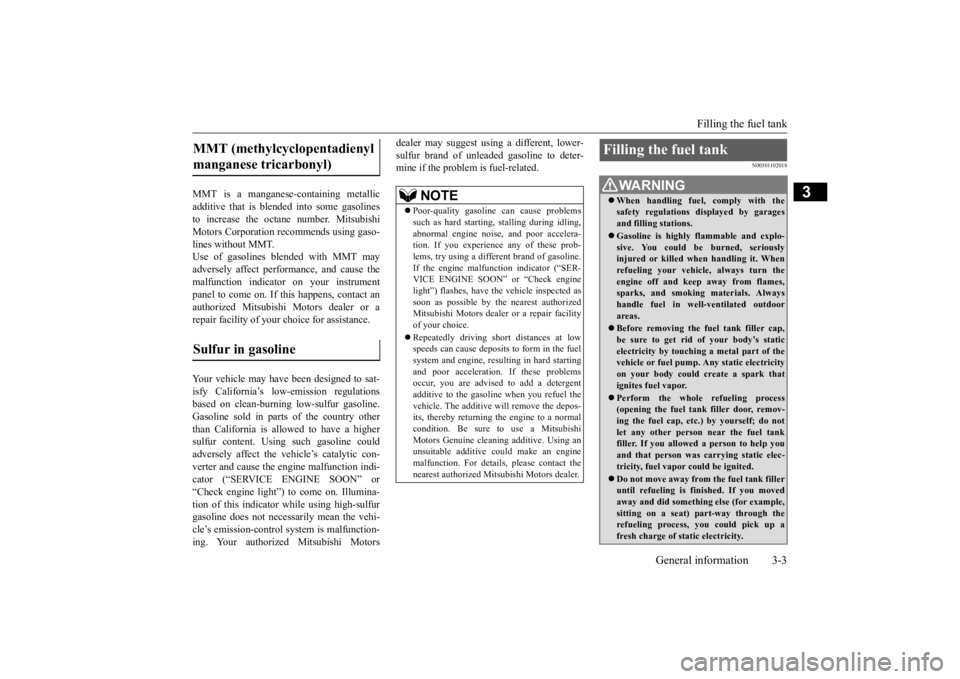
Filling the fuel tank
General information 3-3
3
MMT is a manganese-containing metallic additive that is blended into some gasolines to increase the octane number. Mitsubishi Motors Corporation recommends using gaso-lines without MMT. Use of gasolines blended with MMT may adversely affect performance, and cause themalfunction indicator on your instrumentpanel to come on. If this happens, contact an authorized Mitsubishi Motors dealer or a repair facility of your choice for assistance. Your vehicle may have been designed to sat- isfy California’s low-emission regulationsbased on clean-burning low-sulfur gasoline. Gasoline sold in parts of the country other than California is allowed to have a highersulfur content. Using such gasoline could adversely affect the vehicle’s catalytic con- verter and cause the engine malfunction indi-cator (“SERVICE ENGINE SOON” or “Check engine light”) to come on. Illumina- tion of this indicator while using high-sulfurgasoline does not necessarily mean the vehi- cle’s emission-control system is malfunction- ing. Your authorized Mitsubishi Motors
dealer may suggest using a different, lower- sulfur brand of unleaded gasoline to deter- mine if the problem is fuel-related.
N00301102018
MMT (methylcyclopentadienyl manganese tricarbonyl) Sulfur in gasoline
NOTE
Poor-quality gasoline can cause problems such as hard starting, stalling during idling, abnormal engine noise, and poor accelera- tion. If you experience any of these prob-lems, try using a different brand of gasoline. If the engine malfunction indicator (“SER- VICE ENGINE SOON” or “Check enginelight”) flashes, have the vehicle inspected as soon as possible by the nearest authorized Mitsubishi Motors dealer or a repair facilityof your choice. Repeatedly driving short distances at low speeds can cause deposits to form in the fuel system and engine, resulting in hard starting and poor acceleration. If these problemsoccur, you are advised to add a detergent additive to the gasoline when you refuel the vehicle. The additive will remove the depos-its, thereby returning the engine to a normal condition. Be sure to use a Mitsubishi Motors Genuine cleaning additive. Using anunsuitable additive could make an engine malfunction. For details, please contact the nearest authorized Mitsubishi Motors dealer.
Filling the fuel tank
WA R N I N G When handling fuel, comply with the safety regulations displayed by garages and filling stations. Gasoline is highly flammable and explo- sive. You could be burned, seriously injured or killed when handling it. Whenrefueling your vehicle, always turn the engine off and keep away from flames, sparks, and smoking materials. Alwayshandle fuel in well-ventilated outdoor areas. Before removing the fuel tank filler cap, be sure to get rid of your body’s static electricity by touching a metal part of thevehicle or fuel pump. Any static electricity on your body could create a spark that ignites fuel vapor. Perform the whole refueling process (opening the fuel tank filler door, remov-ing the fuel cap, etc.) by yourself; do not let any other person near the fuel tank filler. If you allowed a person to help youand that person was carrying static elec- tricity, fuel vapor could be ignited. Do not move away from the fuel tank filler until refueling is finished. If you movedaway and did something else (for example, sitting on a seat) part-way through the refueling process, you could pick up afresh charge of static electricity.
BK0277700US.bo
ok 3 ページ 2019年3月8日 金曜日 午前9時23分
Page 43 of 427
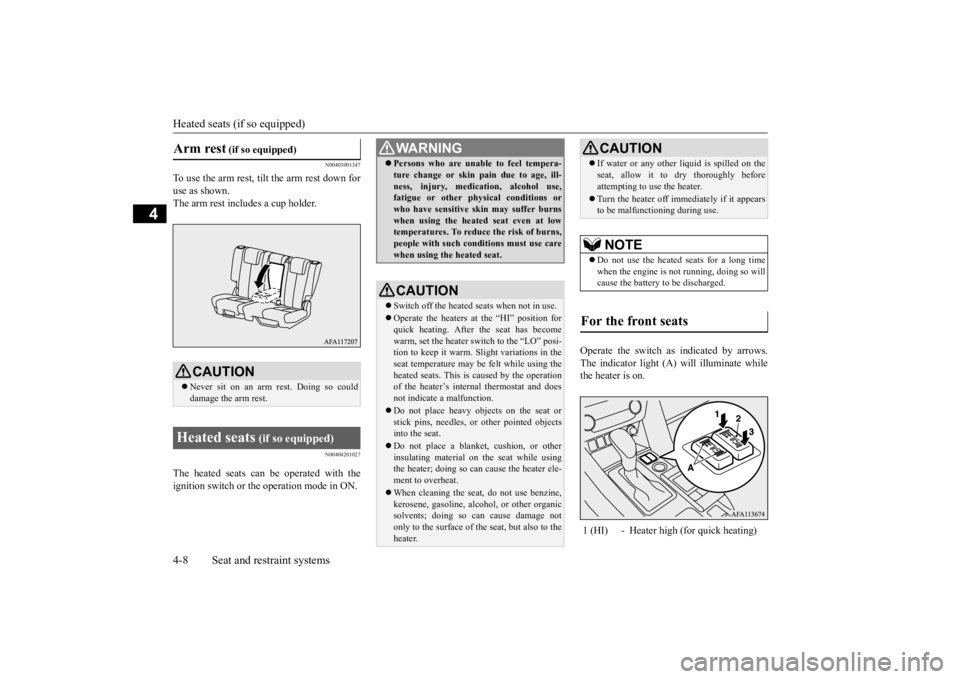
Heated seats (if so equipped) 4-8 Seat and restraint systems
4
N00403001347
To use the arm rest, tilt the arm rest down for use as shown.The arm rest includes a cup holder.
N00404201027
The heated seats can be operated with the ignition switch or the operation mode in ON.
Operate the switch as indicated by arrows. The indicator light (A) will illuminate while the heater is on.
Arm rest
(if so equipped)
CAUTION Never sit on an arm rest. Doing so could damage the arm rest.
Heated seats
(if so equipped)
WA R N I N G Persons who are unable to feel tempera- ture change or skin pain due to age, ill- ness, injury, medication, alcohol use, fatigue or other physical conditions or who have sensitive skin may suffer burnswhen using the heated seat even at low temperatures. To reduce the risk of burns, people with such conditions must use carewhen using the heated seat.CAUTION Switch off the heated seats when not in use.Operate the heaters at the “HI” position for quick heating. After the seat has become warm, set the heater switch to the “LO” posi-tion to keep it warm. Slight variations in the seat temperature may be felt while using the heated seats. This is caused by the operationof the heater’s internal thermostat and does not indicate a malfunction. Do not place heavy objects on the seat or stick pins, needles, or other pointed objects into the seat. Do not place a blanket,
cushion, or other
insulating material on the seat while using the heater; doing so can cause the heater ele- ment to overheat. When cleaning the seat, do not use benzine, kerosene, gasoline, alcohol, or other organicsolvents; doing so can cause damage not only to the surface of the seat, but also to the heater.
If water or any other li
quid is spilled on the
seat, allow it to dry thoroughly before attempting to use the heater. Turn the heater off immediately if it appears to be malfunctioning during use.NOTE
Do not use the heated seats for a long time when the engine is not running, doing so will cause the battery to be discharged.
For the front seats
1 (HI) - Heater high (for quick heating)
CAUTION
BK0277700US.bo
ok 8 ページ 2019年3月8日 金曜日 午前9時23分
Page 49 of 427
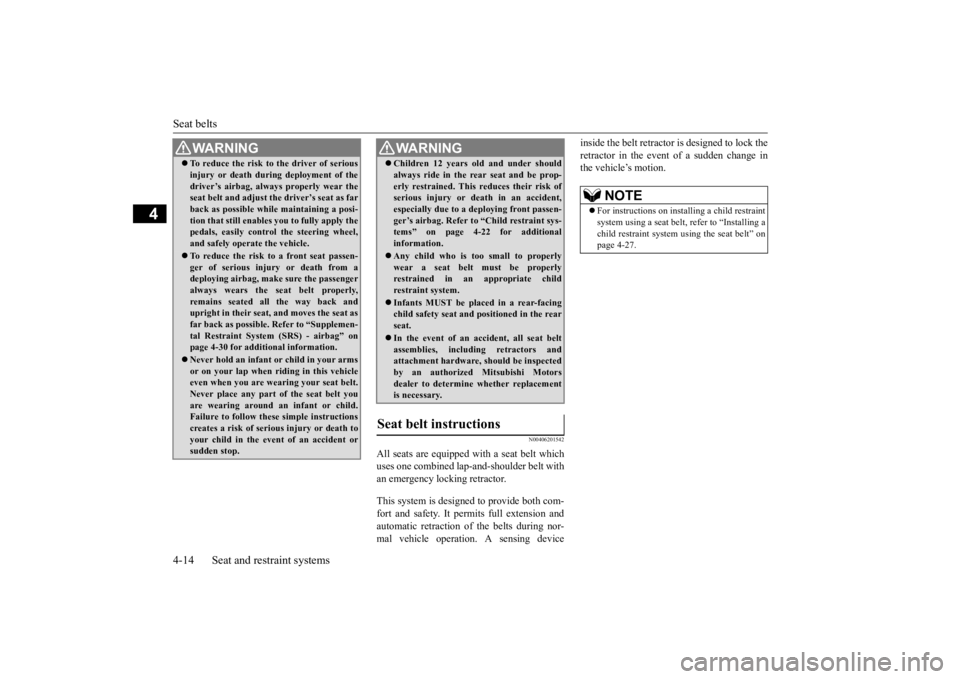
Seat belts 4-14 Seat and restraint systems
4
N00406201542
All seats are equipped with a seat belt which uses one combined lap-and-shoulder belt with an emergency locking retractor. This system is designed to provide both com- fort and safety. It permits full extension and automatic retraction of the belts during nor- mal vehicle operation. A sensing device
inside the belt retractor is designed to lock the retractor in the event of a sudden change in the vehicle’s motion.
To reduce the risk to the driver of serious injury or death during deployment of the driver’s airbag, always properly wear the seat belt and adjust the driver’s seat as far back as possible while maintaining a posi-tion that still enables you to fully apply the pedals, easily control the steering wheel, and safely operate the vehicle. To reduce the risk to a front seat passen- ger of serious injury or death from adeploying airbag, make sure the passenger always wears the seat belt properly, remains seated all the way back andupright in their seat, and moves the seat as far back as possible. Refer to “Supplemen- tal Restraint System (SRS) - airbag” onpage 4-30 for additional information. Never hold an infant or child in your arms or on your lap when riding in this vehicle even when you are wearing your seat belt. Never place any part of the seat belt youare wearing around an infant or child. Failure to follow these simple instructions creates a risk of serious injury or death toyour child in the event of an accident or sudden stop.WA R N I N G
Children 12 years old and under should always ride in the rear seat and be prop- erly restrained. This reduces their risk of serious injury or death in an accident, especially due to a deploying front passen-ger’s airbag. Refer to “Child restraint sys- tems” on page 4-22 for additional information. Any child who is too small to properly wear a seat belt must be properlyrestrained in an appropriate child restraint system. Infants MUST be placed in a rear-facing child safety seat and positioned in the rear seat. In the event of an accident, all seat belt assemblies, including retractors andattachment hardware, should be inspected by an authorized Mitsubishi Motors dealer to determine whether replacementis necessary.
Seat belt instructions
WA R N I N G
NOTE
For instructions on installing a child restraint system using a seat belt, refer to “Installing a child restraint system using the seat belt” on page 4-27.
BK0277700US.bo
ok 14 ページ 2019年3月8日 金曜日 午前9時23分
Page 76 of 427
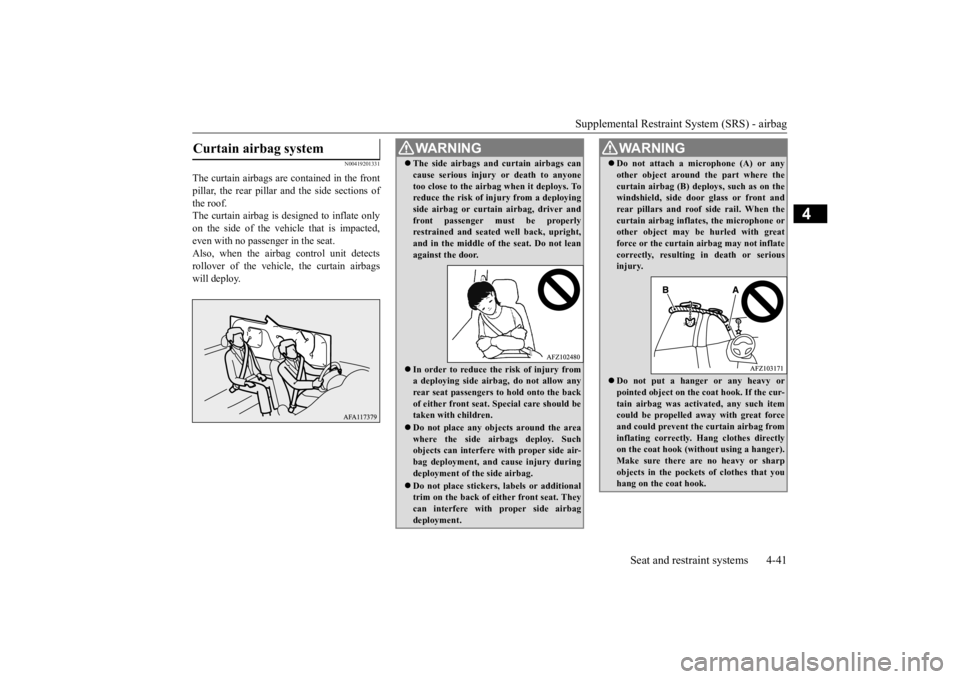
Supplemental Restraint System (SRS) - airbag
Seat and restraint systems 4-41
4
N00419201331
The curtain airbags are contained in the front pillar, the rear pillar and the side sections ofthe roof. The curtain airbag is designed to inflate only on the side of the vehicle that is impacted,even with no passenger in the seat. Also, when the airbag control unit detects rollover of the vehicle, the curtain airbagswill deploy.Curtain airbag system
WA R N I N G The side airbags and curtain airbags can cause serious injury or death to anyone too close to the airbag when it deploys. To reduce the risk of injury from a deploying side airbag or curtain airbag, driver andfront passenger must be properly restrained and seated well back, upright, and in the middle of the seat. Do not leanagainst the door. In order to reduce the risk of injury from a deploying side airbag, do not allow anyrear seat passengers to hold onto the back of either front seat. Special care should be taken with children. Do not place any objects around the area where the side airbags deploy. Suchobjects can interfere with proper side air- bag deployment, and cause injury during deployment of the side airbag. Do not place stickers, labels or additional trim on the back of either front seat. They can interfere with proper side airbag deployment.
Do not attach a microphone (A) or any other object around the part where the curtain airbag (B) deploys, such as on the windshield, side door glass or front and rear pillars and roof side rail. When thecurtain airbag inflates, the microphone or other object may be hurled with great force or the curtain airbag may not inflatecorrectly, resulting in death or serious injury. Do not put a hanger or any heavy or pointed object on the coat hook. If the cur- tain airbag was activated, any such item could be propelled away with great forceand could prevent the curtain airbag from inflating correctly. Hang clothes directly on the coat hook (without using a hanger).Make sure there are no heavy or sharp objects in the pockets of clothes that you hang on the coat hook.WA R N I N G
BK0277700US.bo
ok 41 ページ 2019年3月8日 金曜日 午前9時23分
Page 77 of 427
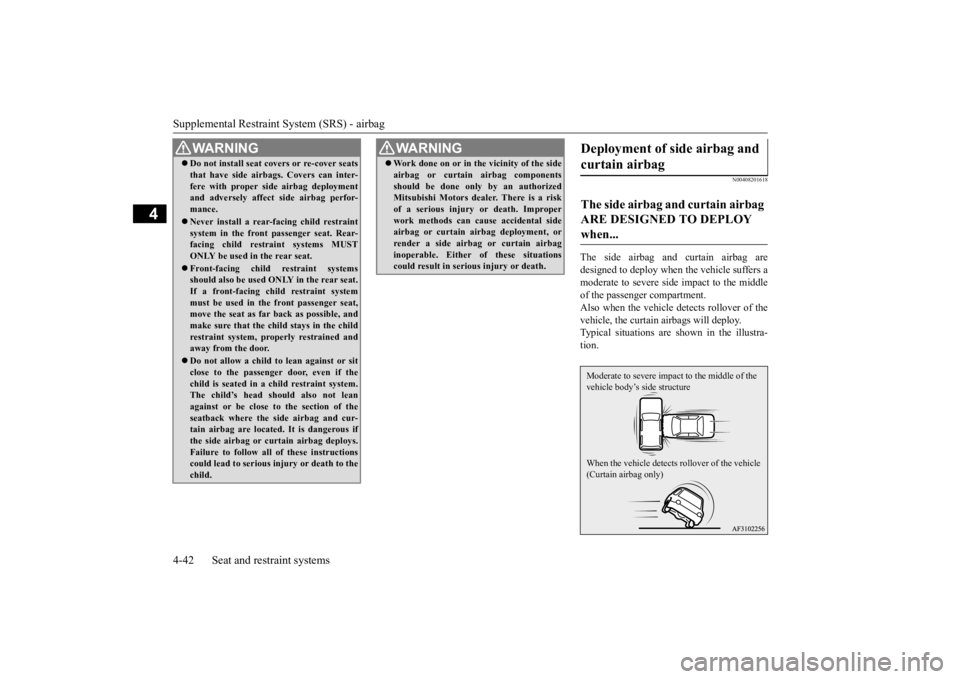
Supplemental Restraint System (SRS) - airbag 4-42 Seat and restraint systems
4
N00408201618
The side airbag and curtain airbag are designed to deploy when the vehicle suffers amoderate to severe side impact to the middle of the passenger compartment. Also when the vehicle detects rollover of thevehicle, the curtain airbags will deploy. Typical situations are
shown in the illustra-
tion.
Do not install seat covers or re-cover seats that have side airbags. Covers can inter- fere with proper side airbag deployment and adversely affect side airbag perfor- mance. Never install a rear-facing child restraint system in the front passenger seat. Rear-facing child restraint systems MUST ONLY be used in the rear seat. Front-facing child restraint systems should also be used ONLY in the rear seat. If a front-facing child restraint systemmust be used in the front passenger seat, move the seat as far back as possible, and make sure that the child stays in the childrestraint system, properly restrained and away from the door. Do not allow a child to lean against or sit close to the passenger door, even if the child is seated in a child restraint system.The child’s head should also not lean against or be close to the section of the seatback where the side airbag and cur-tain airbag are located. It is dangerous if the side airbag or curtain airbag deploys. Failure to follow all of these instructionscould lead to serious injury or death to the child.WA R N I N G
Work done on or in the vicinity of the side airbag or curtain airbag components should be done only by an authorized Mitsubishi Motors dealer. There is a risk of a serious injury or death. Improperwork methods can cause accidental side airbag or curtain airbag deployment, or render a side airbag or curtain airbaginoperable. Either of these situations could result in serious injury or death.WA R N I N G
Deployment of side airbag and curtain airbag The side airbag and curtain airbag ARE DESIGNED TO DEPLOY when... Moderate to severe impa
ct to the middle of the
vehicle body’s side structure When the vehicle detects rollover of the vehicle (Curtain airbag only)
BK0277700US.bo
ok 42 ページ 2019年3月8日 金曜日 午前9時23分
Page 107 of 427
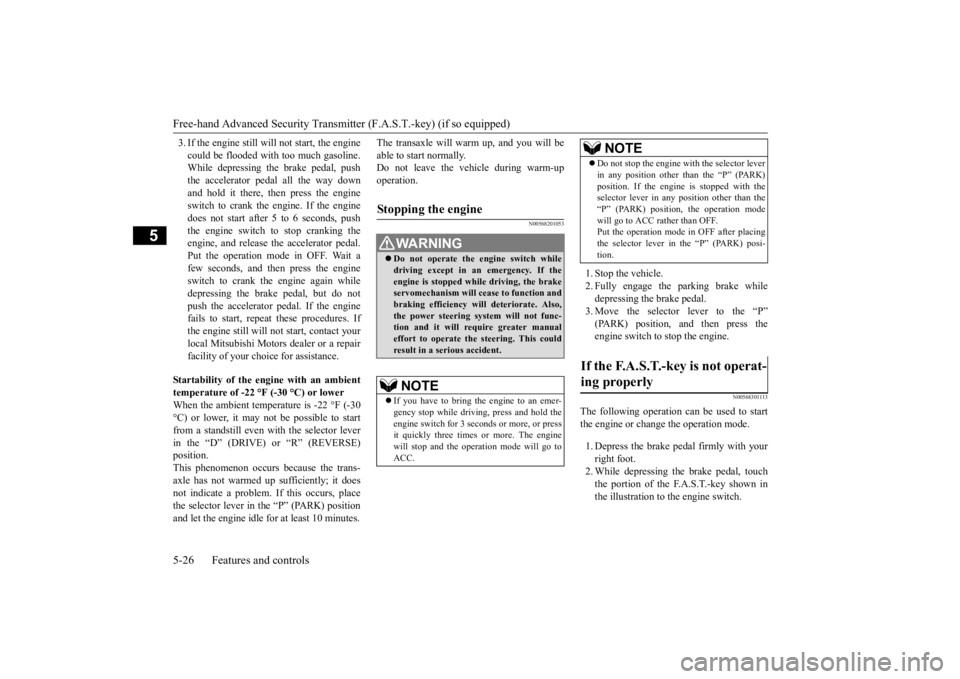
Free-hand Advanced Security Transmitter (F.A.S.T.-key) (if so equipped) 5-26 Features and controls
5
3. If the engine still will not start, the engine could be flooded with too much gasoline. While depressing the brake pedal, push the accelerator pedal all the way downand hold it there, then press the engine switch to crank the engine. If the engine does not start after 5 to 6 seconds, pushthe engine switch to stop cranking the engine, and release the accelerator pedal. Put the operation mode in OFF. Wait afew seconds, and then press the engineswitch to crank the engine again while depressing the brake pedal, but do not push the accelerator pedal. If the enginefails to start, repeat these procedures. If the engine still will not start, contact your local Mitsubishi Motors dealer or a repairfacility of your choice for assistance.
Startability of the engine with an ambient temperature of -22 °F (-30 °C) or lower When the ambient temperature is -22 °F (-30°C) or lower, it may not be possible to start from a standstill even with the selector lever in the “D” (DRIVE) or “R” (REVERSE)position. This phenomenon occurs because the trans- axle has not warmed up sufficiently; it doesnot indicate a problem. If this occurs, place the selector lever in the “P” (PARK) position and let the engine idle for at least 10 minutes.
The transaxle will warm up, and you will be able to start normally. Do not leave the vehicle during warm-up operation.
N00568201053
1. Stop the vehicle.2. Fully engage the parking brake while depressing the brake pedal. 3. Move the selector lever to the “P”(PARK) position, and then press the engine switch to stop the engine.
N00568301113
The following operation can be used to start the engine or change the operation mode. 1. Depress the brake pe
dal firmly with your
right foot. 2. While depressing the brake pedal, touch the portion of the F.A.S.T.-key shown inthe illustration to the engine switch.
Stopping the engine
WA R N I N G Do not operate the engine switch while driving except in an emergency. If the engine is stopped while driving, the brake servomechanism will cease to function andbraking efficiency will deteriorate. Also, the power steering system will not func- tion and it will require greater manualeffort to operate the steering. This could result in a serious accident.NOTE
If you have to bring the engine to an emer- gency stop while driving, press and hold the engine switch for 3 seco
nds or more, or press
it quickly three times or more. The enginewill stop and the operation mode will go to ACC.
Do not stop the engine with the selector lever in any position other than the “P” (PARK) position. If the engine is stopped with the selector lever in any position other than the “P” (PARK) position, the operation modewill go to ACC rather than OFF. Put the operation mode in OFF after placing the selector lever in the “P” (PARK) posi-tion.
If the F.A.S.T.-key is not operat- ing properly
NOTE
BK0277700US.bo
ok 26 ページ 2019年3月8日 金曜日 午前9時23分